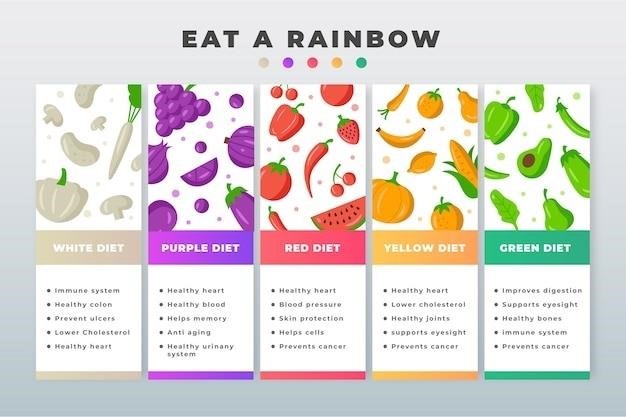Understanding Low-Fat Diets
A low-fat diet emphasizes reducing dietary fat intake for potential health benefits. Understanding food labels and differentiating saturated from unsaturated fats is crucial. Many resources, including printable PDF lists, can guide meal planning.
Reading Food Labels for Fat Content
Deciphering food labels is paramount for successful low-fat dieting. Pay close attention to the “Nutrition Facts” panel, specifically the “Total Fat,” “Saturated Fat,” and “Trans Fat” entries. These values are expressed in grams and as a percentage of the recommended daily intake. Understanding these figures allows you to compare products and make informed choices. Remember that “low-fat” doesn’t always equate to “healthy.” Some low-fat products compensate for reduced fat with added sugar or unhealthy additives. Always check the ingredient list for potential hidden sources of fat and unwanted ingredients. Prioritize whole, unprocessed foods whenever possible, as their labels tend to be simpler and easier to understand. Reading labels empowers you to make conscious dietary decisions aligned with your low-fat goals, facilitating a healthier lifestyle.
Types of Fats⁚ Saturated vs. Unsaturated
Not all fats are created equal. Saturated fats, typically solid at room temperature (like butter and lard), are linked to increased LDL (“bad”) cholesterol levels. Conversely, unsaturated fats, often liquid at room temperature (like olive oil and avocados), can help lower LDL cholesterol and raise HDL (“good”) cholesterol. Unsaturated fats are further categorized into monounsaturated and polyunsaturated fats, both beneficial for heart health. Trans fats, formed through a process called hydrogenation, are particularly harmful and should be avoided. They raise LDL cholesterol and lower HDL cholesterol, increasing the risk of heart disease. Food labels often list the amounts of each fat type, enabling you to make informed choices and prioritize foods rich in healthy unsaturated fats while minimizing those high in saturated and trans fats. This distinction is vital for achieving a balanced and heart-healthy low-fat diet.
Creating a Low-Fat Meal Plan
Planning low-fat meals requires careful consideration of food choices. Prioritize lean proteins, fruits, vegetables, and whole grains. Utilize printable food lists and recipe resources for guidance.
Low-Fat Foods to Include
A successful low-fat diet hinges on incorporating a variety of nutrient-rich, low-fat foods. Prioritize lean protein sources such as skinless poultry, fish (especially fatty fish like salmon for omega-3s), beans, lentils, and tofu. These provide essential amino acids without excessive fat. Abundant fruits and vegetables are crucial, offering vitamins, minerals, and fiber while keeping calories and fat low. Opt for whole grains like oats, brown rice, and quinoa over refined grains. These provide sustained energy and fiber, aiding digestion and satiety. Incorporate low-fat dairy choices like skim milk or nonfat yogurt for calcium and protein. Healthy fats, in moderation, are also vital; include sources like avocados, nuts (in small portions), and olive oil. Remember, balance is key; a diverse selection ensures you meet your nutritional needs without compromising your low-fat goals. Consult printable low-fat food lists and meal plans for practical guidance and recipe ideas.
Foods to Limit or Avoid
To effectively manage fat intake on a low-fat diet, certain food categories require mindful limitation or avoidance. Saturated and trans fats are primary targets; these are found abundantly in many processed foods, red meats, full-fat dairy products, and fried foods. These fats significantly raise LDL (“bad”) cholesterol, increasing the risk of heart disease. Limit or eliminate processed snacks like chips, cookies, and pastries, often high in unhealthy fats and added sugars. Be cautious of hidden fats in sauces, dressings, and condiments; opt for low-fat or fat-free alternatives. When consuming red meat, choose lean cuts and trim visible fat before cooking. While some fats are beneficial, excessive intake of any fat can hinder weight management due to its high caloric density. Regularly review printable low-fat food lists and meal plans to stay informed about which foods to minimize and how to make healthy substitutions. Remember, moderation is key, but mindful avoidance of these categories can significantly aid in achieving your dietary goals.

Sample Low-Fat Food Lists
This section provides examples of low-fat foods categorized for easy meal planning. Printable PDFs offer convenient, organized lists for grocery shopping and recipe creation.
Printable Low-Fat Food Lists and Meal Plans
Downloadable low-fat food lists and meal plans offer a structured approach to healthy eating. These convenient PDFs categorize foods, simplifying grocery shopping and recipe selection. Many websites and health resources provide free printable versions, often organized by food groups (fruits, vegetables, proteins, etc.). Some even include calorie counts and nutritional information. Using a printable list helps maintain consistency and track progress towards dietary goals. Consider utilizing these tools alongside a registered dietitian’s advice for personalized guidance. Remember to adjust portion sizes to meet individual caloric needs. A well-planned low-fat diet, aided by these helpful resources, is a significant step towards better health and well-being. Don’t hesitate to search online for “printable low-fat meal plan” or “low-fat food list PDF” to find a variety of options tailored to different preferences and dietary needs. These printable resources serve as a readily available reference, ensuring that healthy eating remains manageable and enjoyable.
Resources for Low-Fat Recipes
Numerous online and offline resources offer a wealth of low-fat recipes. Websites dedicated to healthy cooking often feature extensive collections, categorized by meal type (breakfast, lunch, dinner, snacks) or dietary restrictions. Many recipe blogs and websites provide detailed instructions, nutritional information, and attractive photos. Cookbooks specializing in low-fat cuisine offer a curated selection of recipes, often with tips and techniques for preparing delicious and healthy meals. Consider exploring online recipe databases that allow filtering by dietary parameters, including fat content. Subscription services may also provide access to a large library of low-fat recipes, often with personalized meal planning tools. Don’t forget the value of traditional cookbooks, as many offer classic dishes adapted for low-fat preparation. Remember that adapting existing recipes often involves simple substitutions, such as using low-fat dairy products or cooking methods that minimize added fats. Experimenting with herbs, spices, and flavorful sauces can enhance the taste of low-fat dishes without compromising their health benefits. The abundance of available resources ensures that a low-fat diet doesn’t mean sacrificing culinary enjoyment.
Benefits of a Low-Fat Diet
Weight management and reduced risk of heart disease are key benefits. Lower calorie intake and improved cholesterol levels are often observed. A balanced approach is essential to avoid nutrient deficiencies.
Weight Management and Calorie Control
Fat contains more calories per gram than carbohydrates or protein. Therefore, reducing fat intake can significantly lower overall calorie consumption, contributing to weight loss or maintenance. Many low-fat foods are naturally filling due to their fiber content, promoting satiety and reducing the likelihood of overeating. This is particularly helpful for individuals aiming to manage their weight. However, it’s important to note that simply reducing fat without considering other dietary aspects might lead to an unbalanced diet. A comprehensive approach combining a low-fat diet with regular exercise and mindful eating habits is crucial for achieving sustainable weight management goals. Focusing on nutrient-dense, low-fat options helps prevent deficiencies while supporting calorie control. Remember to consult a healthcare professional or registered dietitian for personalized guidance on a low-fat diet plan tailored to your specific needs and health status.
Reduced Risk of Certain Diseases
Studies suggest a correlation between low-fat diets and a reduced risk of certain diseases. Lowering saturated and trans fat intake can positively impact cholesterol levels, potentially decreasing the risk of cardiovascular diseases like heart disease and stroke. Some research indicates that a low-fat diet may also play a role in mitigating the risk of certain types of cancer, although more research is needed to establish definitive links. It’s vital to remember that a low-fat diet is just one component of a healthy lifestyle; factors such as regular exercise, stress management, and avoiding smoking significantly influence overall health outcomes. A balanced low-fat diet rich in fruits, vegetables, and whole grains provides essential nutrients that support overall well-being and disease prevention. Always consult with healthcare professionals for personalized advice before making significant dietary changes, especially if you have pre-existing health conditions.

Considerations for Low-Fat Diets
Balancing macronutrients is key; ensure adequate protein and carbohydrates. Potential nutrient deficiencies can arise; monitor intake and consider supplements if needed. Consult a healthcare professional for personalized guidance.
Balancing Macronutrients
A successful low-fat diet requires careful attention to macronutrient balance. While limiting fat intake is central, it’s crucial to ensure adequate consumption of carbohydrates and proteins. Carbohydrates provide the body’s primary energy source, fueling daily activities and preventing fatigue. Prioritize complex carbohydrates from whole grains, fruits, and vegetables over refined sugars. Protein is essential for building and repairing tissues, supporting a healthy immune system, and maintaining satiety. Lean protein sources like poultry, fish, beans, and lentils should form a significant part of the diet. The ideal ratio of carbohydrates, proteins, and fats will vary depending on individual needs and goals, but a registered dietitian or healthcare professional can provide personalized guidance to ensure a balanced approach that supports overall health and well-being while adhering to low-fat guidelines. Inadequate intake of any macronutrient can lead to undesirable health consequences, emphasizing the importance of a well-rounded approach to dietary planning.
Potential Nutrient Deficiencies
Restricting fat intake can potentially lead to nutrient deficiencies if not carefully managed. Fats are crucial for absorbing fat-soluble vitamins (A, D, E, and K), and limiting fat consumption may impair the absorption of these essential vitamins. To mitigate this risk, it’s vital to choose nutrient-rich foods. Include plenty of fruits and vegetables, which provide a wide array of vitamins and minerals. Select lean protein sources that are also good sources of various nutrients. Consider incorporating foods fortified with vitamins A, D, E, and K, or discuss supplementation with a healthcare professional. Furthermore, some individuals may experience difficulties maintaining adequate levels of essential fatty acids, omega-3s and omega-6s, which play crucial roles in brain function, inflammation, and overall health. Careful planning and potentially supplementation can help to prevent deficiencies, ensuring a healthy and balanced low-fat diet. Consulting a registered dietitian can provide personalized guidance to address individual needs and prevent any potential nutritional shortfalls.